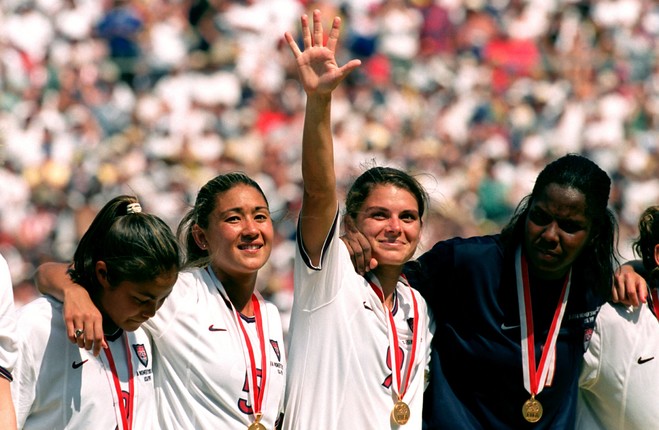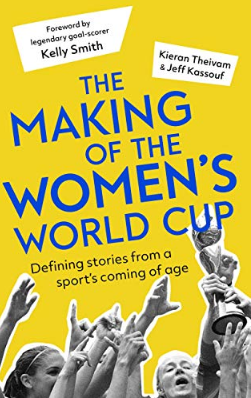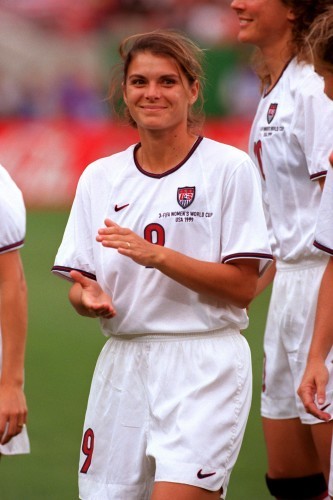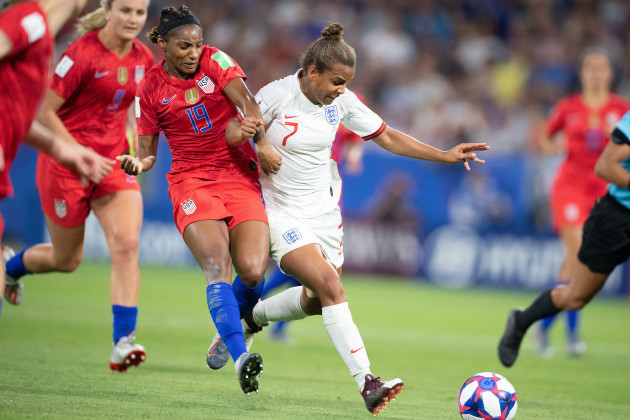THE 2019 WOMEN’S World Cup has been an unequivocal success.
In Ireland, the entire competition has been broadcast on terrestrial TV for the first time ever.
In Britain, TV viewing records have been smashed.
In the US, players such as Megan Rapinoe are increasingly gaining renown for their actions both on and off the field, and becoming global superstars in the process.
The matches themselves have not been short of entertainment, drama or skill.
It is a far cry from the first World Cup in 1991. At the time, interest in women’s soccer was minimal in comparison to where the sport is at today.
A tireless advocate for women’s sport, it was Norwegian delegate Ellen Wille who pushed for the idea at the 45th annual Fifa Congress in 1986.
The men’s World Cup had been in existence for over 50 years by then, so why was there not a female alternative, she argued.
After a test event in 1988 proved successful, Fifa agreed to go ahead with the first official World Cup in China in 1991, albeit with a degree of apprehension.
With Mars Inc the official sponsor, the tournament’s official name at the time was the laboriously titled ‘First Fifa World Championship for Women’s Football for the M&Ms Cup.’
The name proved unpopular, as did the decision to make matches 80 minutes, rather than the traditional 90, as in the men’s game.
“They were afraid our ovaries were going to fall out if we played 90,” US captain April Heinrichs would memorably tell Sports Illustrated in an interview years later.
“There was kind of an element of ‘we have to see how this goes,’ with Fifa organising that first tournament,” Kieran Theivam, a journalist and co-author of a new book ‘The Making of the Women’s World Cup’ written in collaboration with Jeff Kassouf, tells The42.
We didn’t have the first women’s tournament until 1991. I think I can say it now because it was a different era and not the era we live in now. There’s probably an element of ‘we’re having to do this, rather than wanting to do this’. The fact they called it the First Fifa World Championship for Women’s Football for the M&Ms Cup. It was a completely branded name. They didn’t want to call it the Women’s World Cup. They wanted to get away from having it as a parallel to the men’s.
“They were unsure if it was going to be an embarrassment, where we have empty stadiums and poor quality on the field. So there were some people that thought: ‘This is going to fail. It’s just going to be a one-off. We’re not going to have to worry about it [for much longer].’
“But there was enough there to encourage them to organise further tournaments — a proper brand, with it being the Fifa Women’s World Cup. It’s a very different tournament to what we recognise now, but we also have to appreciate that those players laid the foundations for what we have. If it had been an embarrassment, empty stadiums and poor quality on the field, there was a possibility that there might not be another World Cup after that.”
Attendances for the 1991 World Cup in China were remarkably healthy given the lack of publicity for the sport at the time. The average crowd per game was just under 20,000, with 63,000 turning up at the Tianhe Stadium, Guangzhou to see USA beat Norway 2-1 in the final, which is still the second-highest attendance ever for a game at the tournament.
However, as the ‘Making of the Women’s World Cup’ notes: “It is widely assumed factory workers in their thousands were ordered to attend matches and root for teams, including the US… China, it would soon be revealed, was angling to bring the 2000 Summer Olympic Games to Beijing — a vote it would narrowly lose to Sydney, Australia, in 1993 — and the government was motivated to put on a grand event at the 1991 Women’s World Cup.”
Regardless, the tournament’s success was key in aiding the growth of the women’s game and building it into what it has become today.
The 1999 World Cup was another seismic step forward. The final, in which USA beat China on penalties after playing out a 0-0 draw, drew a crowd of 90,185 spectators to the Rose Bowl in Pasadena, which remains a record attendance for the competition to this day.
It led to crossover success for its stars. By 2007, one of the US team’s key players, Mia Hamm, was doing a commercial with basketball legend Michael Jordan.
“I think [1999] changed the game in the United States,” Theivam explains. “Those players 20 years on are still lauded and worshipped by a lot of women’s soccer fans. I’m not quite sure what the impact was in other countries. To be honest, to use England as an example, it’s taken a long time for England to reach that level.
But when the first game at the 1999 tournament took place, the US players were headed to Giants Stadium — the home of the New York Giants NFL team. They couldn’t figure out why there was such a traffic jam going to the stadium and it wasn’t until they got closer and they saw all the US flags that they realised the traffic jam was as a result of their game happening. It was something they’d never seen before and the crowds at that tournament were absolutely phenomenal.
“I spoke to Kristine Lilly, who was a member of that [US] team, a couple of months ago, and she said the players of that squad would randomly turn up at young girls’ coaching sessions with promotional materials and tickets for that World Cup, because they were so worried that people weren’t going to turn up. The best way to make sure they did was to go out and do their own marketing and these random appearances to try to get people interested. It turned out that they had thousands upon thousands of people interested. People like Brandi Chastain were doing TV adverts. It was definitely a turning point for the United States.”
Chastain’s joyful celebration, in which she took off her jersey and fell kneeling to the ground, after scoring the winning penalty against China, has become the tournament’s iconic image. Its 20th anniversary takes place this week and a recent New York Times article described the moment as ‘The Sports Bra Seen Round the World’. With an estimated 40 million Americans watching on TV, Chastain had become famous overnight, as the image of her ecstatic reaction dominated the following day’s sports pages.
It was Hamm, however, despite her introverted nature, that would become the tournament’s true breakout star.
“I hate to describe it this way, but Mia had the full package — the ability on the field and the look as well,” Theivam says. “I don’t like having to use that, but at that time, I think it was more applicable. Michelle Akers as well was an unbelievable player — one of the greatest we’ve seen in the game, scored numerous goals in the tournaments she featured in. But Mia was that icon, that face young girls really related to, because she had the look off the field and the ability on it.
“It’s not something I like to use as an example, because I don’t think a player’s appearance should justify whether an individual is interested in them or not. But for young girls, when they look at someone like Mia Hamm and think she’s presentable, she’s got long dark hair and all that stuff, they relate to that a little bit more. Certainly back then, I’m not sure if it’s as applicable now.
She was the first superstar celebrity of the game, but Mia was one of those that shunned it. She wasn’t one that craved that attention. She did it because she knew that it would raise the profile of the team. She saw the bigger picture and wanted to get that attention on the United States and despite not really wanting that limelight and attention, if she turned it down, she was potentially turning down interest in her team.”
Yet the US are not the only team to have produced superstars. The title of greatest of all time generally boils down to a handful of players. At the forefront of the conversation are Akers, Hamm and another US player, Abby Wambach. China’s Sun Wen, who along with Akers, was named Fifa’s co-player of the century also invariably enters into the conversation. At 23, it seems a little premature to put the phenomenal first-ever female Ballon d’Or winner Ada Hegerberg alongside those aforementioned greats, though at least one current player is deemed worthy of being mentioned in the same breath and many consider her the best of all.
Ever since taking the 2003 World Cup by storm as a 17-year-old, Brazil’s Marta has been voted the world’s best player on six different occasions. Her goals at this year’s World Cup meant she was the first player of either gender to score in five separate incarnations of the competition. Moreover, with 17, she holds the record for most goals ever scored in the competition. In total, she has found the net over 100 times for Brazil and has been similarly prolific at club level.
All of which makes her journey to get to the top level all the more remarkable. Growing up in Dois Riachos, an impoverished area of Brazil, she thrived playing with boys’ teams, simultaneously having to encounter unfortunate but predictable sexism in many instances.
Eventually, this shy young girl was barred from playing with boys and had to leave home at 14, making a three-day trip via bus to try out for the Vasco da Gama women’s team, with no guarantee of success. The venture was only made possible by the support of a couple of family and friends, who recognised Marta’s special talent. Of course, she excelled at this level too, and eventually went on to play football professionally with Umea in Sweden, before moving to the US in 2009 and becoming the star of the newly created pro league there. A World Cup trophy is about the only accolade that has eluded her thus far, coming closest in 2007, as her Brazil side were beaten 2-0 by Germany in the final.
It’s telling that an entire chapter of Theivam’s book is devoted to Marta and of the Brazil legend, he adds: “Marta was the first player that would get you off your feet with what she could do with the ball at her feet.
She had the ability to do things that other players couldn’t. And that Brazil team got to the final of the Women’s World Cup in 2007, and she put the weight of the world on her shoulders and she was 21 years old at the time.
“She had this swagger and ability to embarrass defenders. And we’ve seen players dominate games, but she did it with a style we’ve not seen before. That’s probably why she was the first global superstar and is considered the best and most gifted player to play the women’s game.”
In more recent years too, there has been significant progress in the women’s game on and off the field. The argument over artificial pitches at the 2015 World Cup in Canada is one example of female players standing up for themselves and demanding treatment comparable to that which their male counterparts receive. While there is undoubtedly a long way to go in the battle for equal pay, there have been positive signs of late, such as the historic equal-pay agreement involving Norway’s male and female players.
And while Ireland and Britain have both been slow to embrace women’s football, the national team’s protest for better working conditions with the former and the increased funding and professionalisation of the club game with the latter indicate that times are changing for the better.
“The difference between [England] and the US is that in the US, there are people that don’t look at a woman on a football pitch as out of the ordinary,” Theivam adds. “Football is such a big thing, we are spoon-fed it on almost a daily basis. You can watch men’s football seven days a week and for women’s football to try to find space in such a congested market is difficult.
“There are still some that have old-fashioned views that women don’t belong on a sports field. I think that’s starting to change slowly. There are some that I don’t think we’re ever going to convince. There are some due to cultural surroundings and the upbringing they’ve had, they will not change their mind no matter what we do to try to change it.
“I think the quality of the product as well has got to be commended. I remember watching a women’s football match in the ’90s or early ’00s when I was a kid. It was a Bank Holiday Monday. I think it might have been an FA Cup final. I just remember thinking the quality was not great. I was used to the men’s game. I’d never seen the women’s game before.
You fast-forward 20 years and the standard is so high. I don’t blame those players from 20 years ago. They weren’t full-time or getting the coaching they needed. They didn’t have access to the resources they needed. They weren’t being paid. They were amateur status.
“We’re now starting to see the quality of the product improve, because players are professional in some cases. They’re being paid better and getting better access to medical facilities, gyms, strength and conditioning coaches, so I think that’s the reason it’s [improving], because they’re actually being given a fairer playing field to operate on.”
Undoubtedly, the next big challenge for women’s football is persuading people to watch it on a regular basis. Despite the spectacular viewing figures when it comes to major tournaments, club football has so far failed to attract the same level of popularity. It means leagues such as the WNL in Ireland are struggling, and while the Women’s Super League in England has attracted unprecedented backing in terms of sponsorship, many games are still getting underwhelming attendance figures.
“I’ve covered the women’s game for nearly 10 years,” Theivam adds. “I watched the Euros in 2009, the World Cup in 2011, Euros 2013, Olympics 2012 and 2016. With the exception of the Euros in 2009, because it was relatively low key then, I’ve seen really big interest in major tournaments, people on social media commenting, huge audiences on television, none more so than this World Cup now. Then we see a dropoff when it comes to domestic competitions, largely empty stadiums, we don’t see a huge amount of interest in terms of club football in England, or wherever it might be.
“We look at things like the Women’s World Cup and they’re almost like TV spectator sports, where you have 11.7 million people watching the England-USA game [on BBC], but if you surveyed those 11.7 million people and said: ‘Have you ever been to a women’s football match at a stadium?’ I know the vast majority of them are going to say: ‘No, I haven’t.’
“Now, the question to ask is: ‘Would you consider doing it based on what you’ve seen at this Women’s World Cup?’ If they say yes, they’re going to find ways of making it appealing to them and if they say no, we need to find out why the sport is only enjoyable to a TV audience and [people are] not actually going to experience it in person.
One of my biggest hopes is that we can convert a lot of people who are watching on television and are taking an interest every two years, because of a World Cup and a European Championship, and actually getting them into stadiums. That’s the biggest challenge that clubs face. My hope is that we see that start to change.
“The men’s game for a lot of people will always be their first choice and their first love. To ask people to go and watch their men’s club on a Saturday and their women’s club on a Sunday is essentially asking them to give up their weekend.
“Now we need to find a way where that almost sounds appealing. We’re saying to them: ‘You may be giving up your weekend, but you’re going to get this, this and this by coming to a women’s game. High-class football, a good affordable day out. Women’s football is really affordable compared to the men’s game and other sports.
“It’s a fair question and one I have to answer after every major tournament. If I knew the answer, I would be making a lot of money out of it, because I would be filling stadiums. My hope is that gradually, we will see attitudes change.”
‘The Making of the Women’s World Cup: Defining stories from a sport’s coming of age’ by Kieran Theivam and Jeff Kassouf is published by Little Brown. More info here.
The42 is on Instagram! Tap the button below on your phone to follow us!





